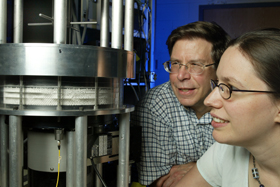
In an experiment originally planned for the International Space Station, physicists at Duke University have devised a controlled, measurable method to make a container of granules -- in this case plastic beads -- "freeze" into the equivalent of a solid-state crystal, or "melt" into the equivalent of a fluid, by alternating the rates that the beads are stirred or shaken.
Results from these experiments also apply to other types of "granular materials," a term scientists use to describe aggregations of solid objects that, according to the circumstances, flow like liquids and gases or clump like solids, said Duke physics professor Robert Behringer, who has spent much of his career studying them. The research was funded by NASA.
"Our technique allows us to both control and measure the effect of different ways to energize a granular material, which has not been possible before," said Behringer, who with his postdoctoral researcher Karen Daniels described the work in a paper published April 29, 2005, in the journal Physical Review Letters.
"What is rather striking about this is that vibration doesn't make a granular system move as expected towards a more fluid-like state, as it would in conventional matter," said Behringer in an interview. "Instead, it has the reverse effect: making it move towards a solid-like crystalline state."
This surprise could have implications for real-world situations involving granular materials, such as predicting the stability of a dirt embankment, or "unjamming" a hopper of coal or gravel, Behringer added.
Daniels, who will soon join the faculty at North CarolinaStateUniversity, worked with Behringer to build a round adjustable chamber with a transparent Plexiglas wall. Small plastic beads inside the chamber are stirred -- physicists call it "shearing" -- by a motor mounted at the top. Meanwhile, an electromagnetic vibrator mounted at the bottom can shake the beads.
"The motivation for this experiment was really to understand how granular materials undergo what's called a jamming transition," Behringer said. That transition, he explained, occurs as particles are pushed so close together that they interlock and become immobile. The Earth's gravity does this all the time, for instance, when blowing or sifting sand grains are pulled down by gravity until they become immobile solid soil.
"If there isn't a sufficiently large shear, solid-like or jammed granular material will not move," he said. "It has been a major focus trying to understand how to characterize changes from that solid-like state to one where the grains can flow."
Instead of simulating a suspended-state condition by simply vibrating the beads, the Duke researchers originally planned to completely free the beads from gravity's pull with an experiment aboard the International Space Station. "We wanted to get around the fact that the Earth compacts everything down," he said. But those research plans ended when NASA redirected its priorities.
Demonstrating their substitute Earth-bound experiment, Daniels first showed how stirring the mixture in the container made the top band of beads move and separate into increasingly disordered conglomerations.
"We thought randomly vibrating them up and down would further break those up," she said. "We proved that to be quite wrong."
Instead, Daniels showed how vibrations unexpectedly made the moving band at the top become more ordered, with the beads increasingly assuming the regular spatial symmetries of crystals.
"As I shake it harder, everything freezes up," she said.
By adjusting the rate of stirring and the rate of vibrating, Behringer said their system can predictably emulate "phase transitions" for granular materials that resemble what happens when liquids freeze into solids or crystalline solids melt into a liquid.
"If you shake at a given level and then start providing more shear, you'll go from a crystalline to a disordered state," he said. "But as you shake harder, it takes more shearing to make the system melt."
As a bonus feature, the experimenters can also induce pressure on the shaking and mixing beads by reducing the chamber's height. "That allows us to move into regimes that have not been accessible before," he said.
Their method may be applicable beyond the laboratory to help resolve some "very common engineering problems," he said. "Suppose that you have an embankment and you want to understand its stability. If you push it past the point where it will start to avalanche, what would those dynamics be?"
For one thing, their surprising results suggest that the embankment may not necessarily behave as expected in an earthquake, he acknowledged. "You might think that vibrations would destabilize the bank, when in fact they could stabilize it."
Their finding might also call into question a common industrial method for loosening materials that have become jammed together inside hoppers. "In some cases devices are used that cause vibrations," he said. "That might not only be an ineffective technique. It might actually compact the material even more."